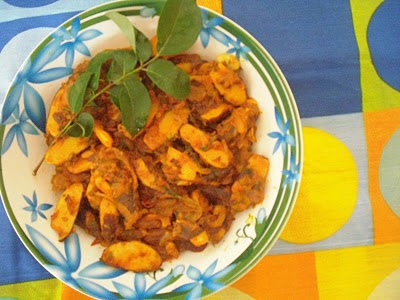Remember I had hosted a promotional giveaway sometime back and Shoba of Anubhavati won the waffle maker. Its time for another giveaway. This time its going to different. Watch this space for the details which will be posted soon.
Now on to the recipe. Apart from pickling raw mangoes, I preserve them in the form of vathals/sun dried mangoes. Fresh mangoes which are sour and raw is chopped into pieces and marinated in salt and kept for a day. During the course, water will be released from the salt and mango juice. Next day, the mango pieces are squeezed and dried in the sun. The dried mangoes are put back in the squeezed salt water and this is repeated, till no water is left in the jar. A day more of drying in the sun leaves you with salted and dried mangoes. Store them in air tight container. It stays good for a year. This mango vattal is made into a vathakuzhambu. In this kuzhambu, red chilly is used mnimally and heat is from peppercorns.
Now on to the recipe. Apart from pickling raw mangoes, I preserve them in the form of vathals/sun dried mangoes. Fresh mangoes which are sour and raw is chopped into pieces and marinated in salt and kept for a day. During the course, water will be released from the salt and mango juice. Next day, the mango pieces are squeezed and dried in the sun. The dried mangoes are put back in the squeezed salt water and this is repeated, till no water is left in the jar. A day more of drying in the sun leaves you with salted and dried mangoes. Store them in air tight container. It stays good for a year. This mango vattal is made into a vathakuzhambu. In this kuzhambu, red chilly is used mnimally and heat is from peppercorns.
You need
Dried Mango pieces - 1/2 cup heaped
Tamarind - goose berry size
Turmeric - a pinch
Salt
To roast
Red chilly - 1 nos
Peppercons - 1/2 tspn
Urad dal- 2 tspn
Cumin seeds - 1/2 tspn
Curry leaves - few
Ghee/Oil - 2 tspn to roast
For Seasoning
Oil - 1 tspn
Mustard seeds - 1 tspn
Methi seeds -a pinch
Hing powder - few shakes
Method
Soak the dried mango pieces in a cup of warm water for 20 minutes to soften. You can also microwave the mango along with water for a minute. Extract tamarind juice. Roast the ingredients in ghee/oil till dal turns brown. Add the cumin seeds towards the end since it gets roasted faster.
Grind the soaked mango pieces along with the roasted ingredients to a smooth paste. You can use the soaked water to grind. Stir in the ground mixture to the tamarind extract. Add salt, tumeric powder and bring to a boil. Let it simmer for a while till the gravy thickens. Season with mustard, hing and methi seeds.
Note:
Adjust the tamarind according to the sourness of the dried mangoes. Since the mangoes have salt in it, add salt keeping that in mind.

.jpg)
.jpg)
.jpg)





















.jpg)
.jpg)















